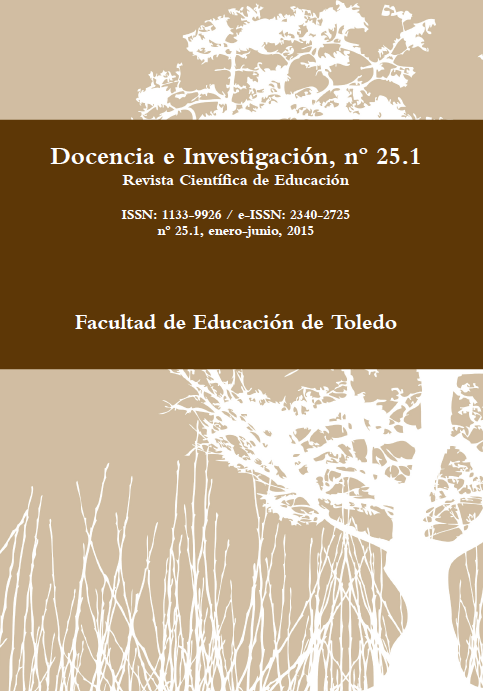Playing with words: L2 vocabulary acquisition and the use of popular tales. A perspective from the Involvement Load Hypothesis
Main Article Content
Abstract
Article Details
Los autores que publican en esta revista están de acuerdo con los siguientes términos:
- Los autores conservan los derechos de autor y garantizan a la revista el derecho de ser la primera publicación del trabajo al igual que licenciado bajo una Creative Commons Attribution License que permite a otros compartir el trabajo con un reconocimiento de la autoría del trabajo y la publicación inicial en esta revista.
- Los autores pueden establecer por separado acuerdos adicionales para la distribución no exclusiva de la versión de la obra publicada en la revista (por ejemplo, situarlo en un repositorio institucional o publicarlo en un libro), con un reconocimiento de su publicación inicial en esta revista.
- Se permite y se anima a los autores a difundir sus trabajos electrónicamente (por ejemplo, en repositorios institucionales o en su propio sitio web) antes y durante el proceso de envío, ya que puede dar lugar a intercambios productivos, así como a una citación más temprana y mayor de los trabajos publicados (Véase The Effect of Open Access) (en inglés).
References
Allen, V. (1983). Techniques in teaching vocabulary. New York: Oxford University Press.
Baddeley, A. (1997). Human Memory: Theory and Practice. London: Erlbaum.
Broeder, P. and Plunkett K. (1994). Connectionism and Second Language Acquisition. In Ellis, N. (Ed.). Implicit and explicit learning of languages (pp. 421-453). London: Academic Press.
Brown, C. (1993). Factors affecting the acquisition of vocabulary. In Huckin, T; Haynes, M. and Coady, J. (Eds.). Second Language Reading and Vocabulary (pp. 263-286). New Jersey: Ablex.
Colomer, T. (2010). Introducción a la literatura infantil y juvenil actual. Madrid: Síntesis.
Common European Framework of Reference for Languages (2001). Retrieved from http://www.coe.int/t/dg4/linguistic/source/framework_en.pdf
Ellis, N. (1994). Vocabulary Acquisition: the ins and outs of explicit cognitive mediation. In Ellis, N. (Ed.). Implicit and explicit learning of languages (pp. 211-282). London: Academic Press.
Ellis, N. and He, X. (1999). The roles of modified input and output in the incidental acquisition of word meanings. Studies in Second Language Acquisition, 21, 285-301.
Folse, K. (2006). The effect of type of written exercise on L2 vocabulary retention. TESOL Journal, 40, 273-293.
Golkar, M. and Yamini, M. (2007). Vocabulary, proficiency and reading comprehension. The Reading Matrix, 7, 88-112.
Hismanoglu, M. (2005). Teaching English through literature. Journal of Language and Linguistic Studies, 1, 53-66.
Hulstijn, J. and Laufer, B. (2001). Some empirical evidence for the Involvement Load Hypothesis in vocabulary acquisition. Language Learning 51, 539-558.
Jiménez Catalán, R.M. and Moreno Espinosa, S. (2005). Using Lex30 to measure the L2 productive vocabulary of Spanish primary learners of EFL. Vial, 13, 27-44.
Jiménez Catalán, R.M. and Terrazas, M. The receptive vocabulary of English foreign language young learners. IJES, 2, 201-215.
Keating, G. (2008). Task effectiveness and word learning in a second language: The involvement load hypothesis on trial. Language Teaching Research, 12, 365-386.
Laufer, B. (1986). Possible changes in attitude towards vocabulary acquisition research. IRAL, 24, 69-75.
Laufer, B. (1995). Beyond 2000: a measure of productive lexicon in a second language. In Eubank, L; Sharwood-Smith, M and Selinker, L. (Eds.). The current state of interlanguage (pp. 265-272). London: Benjamins.
Laufer, B. (1995). The development of passive and active vocabulary in a second language: same or different? Applied Linguistics, 19, 255-271.
Laufer, B. and Hulstijn, J. (2001). Incidental vocabulary acquisition in a second language: The construct of task-induced involvement. Applied Linguistics, 22, 1-26.
Lu, M. (2013). Effects of four vocabulary exercises on facilitating learning vocabulary meaning, form, and use. TESOL Quarterly, 47, 167-176.
McCarthy, M. (1990). Vocabulary. Oxford: Oxford University Press.
Manchón, R.M. (1987). Adquisición/aprendizaje de lenguas: el problema terminológico. Cuadernos de Filología Inglesa, 3, 37-47.
Meara, P. (1992). Network structures and vocabulary acquisition in a foreign language. In Arnaud, P. and Béjoint, H. (Eds.). Vocabulary and Applied Linguistics (pp. 62-70). London: McMillan.
Milton, J. (2009). Measuring second language vocabulary acquisition. Multilingual Matters: Bristol.
Nation, P. (2001). Learning vocabulary in another language. Cambridge: Cambridge University Press.
Nation, P. and Gu, P. (2007). Focus on vocabulary. Sydney: NCELTR.
Newton, J. (1995). Task-based interaction and incidental vocabulary learning: A case study. Second Language Research, 11, 159-177.
Quinn, G. (1968). The English vocabulary of some Indonesian University entrants. Salatiga: English Department Monograph IKIP Kristen Satya Watjana.
Read, J. (2000). Assessing vocabulary. Cambridge: Cambridge University Press.
Richards, J. (1974). Word lists: problems and prospects. RELC Journal, 5, 69-84.
Rodari, G. (2010). Gramática de la fantasía. Barcelona, España: Planeta.
Sell, J. (2005). Why teach literature in the foreign language classroom? Encuentro. Revista de investigación e innovación en la clase de lenguas, 15, 86-93.
Schmitt, N. (2000). Vocabulary in language teaching. Cambridge: Cambridge University Press.
Sparks, R. ; Ganschow, L. ; Patton, J.; Artzer, M.; Siebenhar, D.; and Plageman, M. (1997). Prediction of foreign language proficiency. Journal of Educational Psychology, 89, 549-561.
Takala, S. (1984). Evaluation of students’ knowledge of English vocabulary in the Finnish comprehensive school. Urbana: University of Illinois Press.
